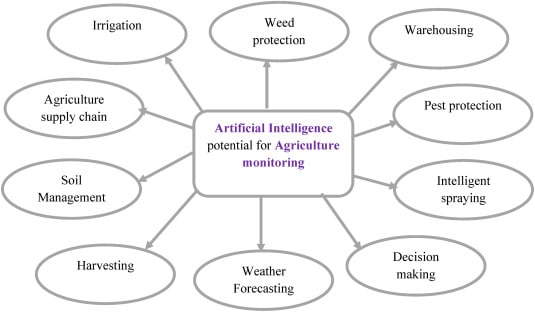Artificial Intelligence (AI) is transforming agriculture, ushering in a new era of farming that enhances productivity, sustainability, and efficiency. But what does this transformation really look like? Many of us find ourselves wondering:
How exactly will technology and AI reshape farming? Will robots replace manual labor in the fields? Will self-driving tractors become the new norm? Could drones autonomously spray crops with pinpoint accuracy? Imagine receiving instant alerts on your smartphone about pest outbreaks, complete with tailored solutions.
In agriculture, AI is like a farm helper that looks at tons of information to figure out the best times for planting and harvesting, and how to use resources wisely. Think of it as your farm’s personal weather forecaster and crop expert rolled into one! It can give you a heads-up about everything from upcoming weather changes to potential pest problems, helping you plan ahead and keep your farm running smoothly.

Source: Understanding the potential applications of Artificial Intelligence in Agriculture Sector
The best part? All these farming tips come right to you through easy-to-use apps, friendly email updates, text messages, or even voice messages – it’s like having a knowledgeable farming buddy right in your pocket!
According to data, field farming accounts for the largest share of AI adoption in agriculture, representing approximately 61.5% of the market in 2024. This dominance highlights the transformative potential of AI in large-scale, open-field farming, where optimizing resources like water, fertilizers, and pest control is critical. The high adoption rate suggests that field farmers recognize the value of AI-driven solutions in addressing challenges like unpredictable weather, pest infestations, and the need for sustainable practices.

Despite the widespread perception that technology adoption in agriculture is accelerating, the reality is more tempered. According to McKinsey’s 2024 Global Farmer Insights report, farmers are indeed embracing new technologies—but at a sluggish pace. The report found only a 3% increase since 2022 in the number of farmers using or willing to adopt at least one digital tool to improve their operations. Some other reasons for this slow adoption are listed below:
Aging Farmer Demographics
The average American farmer, at 58 years old, tends to favor traditional methods and relies more on agronomists than on digital tools, with this age group also showing a marked reluctance to share farm-specific data—further compounding their hesitation to adopt AI-driven solutions.
Limited Internet Access and Infrastructure
While 85% of U.S. farms have internet access, only half of these have broadband connections, which are essential for AI applications requiring high-speed data transmission (USDA study, 2023).
Previous Technology Frustrations
Many farmers recall early digital farming tools as clunky and hard to use, leading to distrust in new systems. Adoption was poor during that first wave of innovation, leaving skepticism about AI and its usability (Global Trade).
High Costs and Unclear ROI
High costs remain the most significant barrier to technology adoption among farmers, with 52% of North American farmers identifying it as a major challenge and 40% citing unclear returns on investment as another key concern, according to McKinsey’s Global Farmer Insights 2024.

One of the most impactful applications of AI in agriculture is pest management, where advanced technologies help monitor, predict, and address pest outbreaks with precision! According to a report, **72% of farmers using these technologies report reduced environmental harm and more efficient resource use**. This means faster and more precise pest control and healthier crops.
Notably, this trend aligns with findings published in Nature, which emphasize that innovations in pesticide application must prioritize environmental impact. By reducing the need for blanket pesticide applications and targeting specific threats, AI-driven solutions help minimize ecological damage while maintaining crop yields.
For instance, AI systems are proving remarkably effective in specific pest prevention tasks:
Do you want to detect insects on your farm with precision and get recommendations? Learn how scoutlabs AI trap can help you.

The integration of AI in agriculture is revolutionizing the industry, offering practical tools that enhance productivity, sustainability, and precision. From advanced pest management systems to predictive analytics for weather and resource optimization, AI empowers farmers to make data-driven decisions with ease. While challenges such as cost and infrastructure remain, the benefits of adopting these technologies far outweigh the hurdles. As innovation continues to shape the future of farming, AI proves to be an indispensable ally for addressing the global demand for efficient and sustainable food production.
